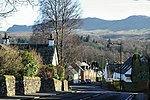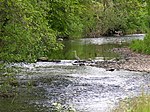Glengoyne distillery
1833 establishments in ScotlandDistilleries in ScotlandOrganisations based in Stirling (council area)Scottish malt whisky

Glengoyne distillery is a whisky distillery continuously in operation since its founding in 1833 at Dumgoyne, north of Glasgow, Scotland. Glengoyne is unique in producing Highland single malt whisky matured in the Lowlands. Located upon the Highland Line, the division between the Highlands and Lowlands of Scotland, Glengoyne’s stills are in the Highlands while maturing casks of whisky rest across the road in the Lowlands.
Excerpt from the Wikipedia article Glengoyne distillery (License: CC BY-SA 3.0, Authors, Images).Glengoyne distillery
A81,
Geographical coordinates (GPS) Address Website External links Nearby Places Show on map
Geographical coordinates (GPS)
| Latitude | Longitude |
|---|---|
| N 56.01403 ° | E -4.36378 ° |
Address
Glengoyne Distillery
A81
G63 9LB
Scotland, United Kingdom
Open on Google Maps








